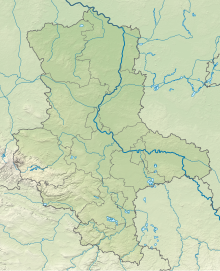Lower hollow
Coordinates: 51 ° 47 ′ 21 ″ N , 12 ° 17 ′ 11 ″ E
The Untere Mulde is a nature reserve in the cities of Raguhn-Jeßnitz and Bitterfeld-Wolfen as well as the municipality of Muldestausee in the district of Anhalt-Bitterfeld and the independent city of Dessau-Roßlau in Saxony-Anhalt .
The nature reserve with the registration number NSG 0120 is around 1191 hectares . It is to a large extent part of the bird sanctuary "Middle Elbe including Steckby-Lödderitzer Forest" and the FFH area "Untere Muldeaue" and partially surrounded by the landscape protection area "Middle Elbe". 208 hectares of the nature reserve are left as a total reserve for undisturbed natural development. The nature reserve was designated in 1961 (date of the current ordinance: December 15, 2003). The "Beaver Protection Area Pelze", which was designated in 1927, was incorporated into it. Responsible lower nature conservation authorities are the district of Anhalt-Bitterfeld and the city of Dessau-Roßlau.
The nature reserve, which consists of three sub-areas, extends within the Middle Elbe Biosphere Reserve for a length of around 25 kilometers along the Mulde from the crossing of the Berlin – Halle railway north of Bitterfeld or below the Mulde reservoir to its confluence with the Elbe between Dessau and Roßlau . The nature reserve is interrupted in Jeßnitz (Anhalt) and Dessau. It represents the river of the well with shore areas and adjoining meadow areas with backwaters under protection. The floodplains are dammed. Within the dykes, the floodplains are subject to the natural flow dynamics. In Jeßnitz (Anhalt) and Dessau, the nature reserve is limited in parts to the course of the river and its banks.
The meandering river course with impact and sliding slopes as well as gravel and sand banks is predominantly accompanied by trees outside the villages. In addition to hardwood floodplain forests , remains of the softwood floodplain and willow bushes can be found. Furthermore, the hollow flows through grassland lying in its floodplain , which is characterized as alternately moist grass clown meadow, foxtail meadow or multi-flowered buttercup meadow . Red fescue meadows and sheep fescue settle in drier and sandy locations . There are also bush societies and orchards . Also arable land have moved into the nature reserve.
Reeds with reeds , bulrushes and swaths of water and various sedge beds , most often the Schlankseggenried, settle on damp locations . Open water areas are marked by duckweed and swimming fern covers, frog bite , crab claw , water feather , horn leaf and water lily societies as well as waterweed societies with Canadian waterweed . Floristic features in the nature reserve are occurrences of winter horsetail and violet stendelwort .
The hollow is the habitat of chub , pike and perch as well as various other fish species. In the Jonitzer Mulde, which is part of the nature reserve below the barrage at Waldersee , u. a. Catfish, asp and wolffish . The oxbow lakes are also of great importance for the fish fauna. Of these, the furs are considered to be particularly rich in species a little above the mouth of the Mulde into the Elbe. In addition to asp and wolffish etc. a. also zope , bitterling , crucian carp , bleak and aland . Large oxbow areas are located in the central area of the nature reserve southwest of Kleutsch .
The nature reserve is of great importance for many bird species as a breeding, resting and wintering area. So live here u. a. Honey Buzzard , Hobby , red and black kite , Middle Spotted Woodpecker , Gray-headed Woodpecker , Common Sandpiper , Ringed Plover and Kingfisher , all also breed in the nature reserve. The steep banks of the Mulde also offer sand martins suitable places for their breeding colonies. Numerous goosander and golden-bellied ducks overwinter here in winter . Amphibians and reptiles are u. a. through spadefoot , toad , tree frog , moor frog and smooth snake represented. The nature reserve is also the habitat of the Elbe beaver and the otter .
Shortly before the mouth of the Mulde into the Elbe, the nature reserve is crossed by the Trebnitz – Leipzig railway and the parallel federal highway 184 , near Dessau by the Dessau – Gohrau-Rehsen railway and south-east of Dessau by the federal highway 9 . Furthermore, individual roads and paths run through parts of the nature reserve. In Jeßnitz (Anhalt), Raguhn and Dessau there are barrages in the Mulde.
literature
- Frank Jurgeit, Frank Eppert, Wolfhart Haenschke: Protected nature in the Muldeaue. ( PDF file , 5.9 MB)
Web links
Individual evidence
- ^ Nature reserve , Mitteldeutsche Zeitung, July 3, 2013. Accessed November 26, 2014.
- ↑ History of nature conservation in Anhalt (PDF file, 30 kB). Retrieved April 12, 2016.





